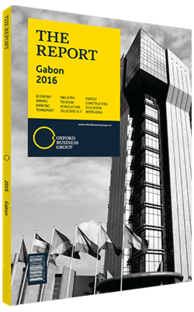Gabon invests in transport infrastructure for economic growth
With a new urgency in the wake of falling oil prices, Gabon is in the midst of a significant overhaul of its transport infrastructure, rolling out a series of new projects to accelerate diversification efforts. Several of the investments – which include a new port and road upgrades – are scheduled for completion by the end of 2016. When finished, they should help reduce the country’s high transport and handling costs in targeted sectors, including mining and agriculture.
Port Prerogatives
At the heart of Gabon’s transport infrastructure drive is the multi-modal rail-sea port being developed at Owendo, 15 km south of the capital Libreville, at an estimated cost of CFA133.6bn (€200.4m). Scheduled to be operational by early 2017, the Gabon Special Economic Zone (SEZ) Mineral Port will extend over a 45-ha site and house three terminals – one for minerals, with a 10m-tonne capacity per annum; a second facility for fish; and a third for aggregate. It will also include a naval shipyard.
The Owendo complex dovetails with Gabon’s plans to boost the mining sector’s contribution to GDP from 6% to 25% over the next 15-20 years. Currently, the industry is served by just one facility, also located in Owendo: the manganese-exporting port owned by the Compagnie des Mines de l’Ogooué (Comilog). Expanded capacity in Owendo should help improve turnaround times. The Comilog port, for example, saw 130,000 twenty-foot equivalent units (TEUs) of container traffic in 2013, in excess of the port’s handling capacity of 120,000 TEUs.
In addition to connecting with the 648-km Trans-gabonais rail line, which already links Owendo with Franceville in the south-east, Gabon is exploring the development of two additional railways – one linking the Port of Owendo to the export-oriented Nkok SEZ, also near Libreville, and the other connecting the port to the Bélinga iron ore mine in the north-east.
Commodity exports will also benefit from a four-lane highway project currently under way that will link Libreville to the northbound national highway. Scheduled to be completed by the end of 2016, the new highway aims to reduce traffic in the capital and create a more direct point of access to the Nkok SEZ.
The highway forms part of Gabon’s broader national road development plan, which, according to Jean-Pierre Oyiba, minister of infrastructure, public works and regional planning, represents 10-15% of GDP, accounts for around 30-40% of public investment and employs some 15,500 Gabonese nationals.
Other road projects include the 93-km Port-Gentil-Omboué motorway, scheduled for completion in 2017. The CFA102bn (€153m) project aims to improve connectivity with the second city of Port-Gentil – which, in addition to being the epicentre of the hydrocarbons sector, is also being targeted for development of an SEZ, a new port and a fertiliser plant.
Regional Connectivity
Gabon, together with some of its neighbours, is also looking to regional infrastructure investment to reinvigorate growth. Weak transport infrastructure has been identified as a primary hurdle to boosting regional trade and economic growth, with just two of the six capital cities in the CEMAC zone currently connected by highways. At present, intra-regional trade among CEMAC states is minimal and lags behind other economic blocs on the continent. In the East African Community, for example, trade among member states is well above one-third of total trade value, compared to 1.2% in CEMAC, as per data from the United Bank for Africa.
The issue ranked high on the agenda of talks held in Cameroon at the beginning of 2016 between CEMAC ministers of finance and Christine Lagarde, managing director of the IMF. Lagarde had positive words for the countries’ collaborative efforts, while pledging the IMF’s continued support. “Reducing barriers to regional trade and implementing regional infrastructure projects could help to address competitiveness challenges facing the CEMAC countries,” she said.
You have reached the limit of premium articles you can view for free.
Choose from the options below to purchase print or digital editions of our Reports. You can also purchase a website subscription giving you unlimited access to all of our Reports online for 12 months.
If you have already purchased this Report or have a website subscription, please login to continue.

